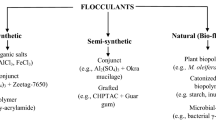Abstract
Particularly high population densities are readily sustainable in newly designed glass column reactors. The optimal density ofIsochrysis galbana in these columns in summer was 4.6 g L−1 dry algal mass at which value the highest sustainable productivity obtained was a record of 1.6 g L−1 d−1. The population density exerted a direct effect on productivity: The higher the light intensity, the more pronounced was the dependence of the output rate on the population density, variations of 10%± from the optimal density resulting in a significant decline in productivity. The population density had also a very significant effect on the course of photoadaptation which took place during the first days after transferring the cultures from the laboratory to the outdoors. The output rate was lower by 5 to 35% on the first day of such transfer as compared to the light-adapted control. The higher the cell density, the faster was the process of photoadaptation as indicated by the rise of the productivity and O2 tension to the control level. The potential for excess light damages was most prominent in the column reactors used, in which the light path was much reduced compared with that in open raceways. Significant photoinhibition took place at below optimal population density (2.8–3.8 g L−1), and when cell density was further reduced (1.9 to 1.1 g L−1), exposure to full sunlight caused photooxidative death within a few hours. The pattern of O2 concentration in the culture that emerged along the day served as a useful indicator of photolimitation.
Similar content being viewed by others
References
Abeliovich A, Shilo M (1972) Photooxidative death in blue-green algae. J. Bact. 111: 682–689.
Boussiba S. Sandbank E. Shelef G, Cohen Z, Vonshak A, Ben-Amotz A, Arad S, Richmond A (1988) Outdoor cultivation of the Marine MicroalgaIsochrysis galbana in the open reactors. Aquaculture 72: 247–253.
Hartig P, Grobbelaar JU, Soeder CJ, Groeneweg J (1988) On the mass culture of microalgae: Areal density as an important factor for achieving maximal productivity. Biomass 15: 211–221.
Kaplan D, Cohen Z, Abeliovich A (1986) Optimal growth conditions forIsochrysis galbana. Biomass 9: 37–48.
Myers J. Grham J O-Ruth (1958) On the mass culture of algae. II. Yield as a function of cell concentration under continuous sunlight irradiance. Plant Physiol. 34: 345–352.
Renaud SM, Parry DL, Luong-Van , Thinh C, Kuo C, Padovan A, Sammy N. (1991) Effect of light intensity on the proximate biochemical and fatty acid composition ofIsochrysis sp. andNannochloropsis oculata for use in tropical aquaculture. J. appl. Phycol. 3: 43–53.
Richmond A (1987) The challenge confronting industrial microalgaculture: High photosynthetic efficiency in large-scale reactors. Hydrobiologia 151/152 117–121.
Richmond A, Boussiba S, Vonshak A, Kopel R (1993) A new tubular reactor for mass production of microalgae outdoors. J. appl. Phycol. 5: 327–332.
Richmond A, Lichtenberg E, Stahl B, Vonshak A (1990) Quantitative assessment of the major limitations on productivity ofSpirulina platensis in open raceways. J. appl. Phycol. 2: 195–206.
Soeder CJ (1980). Mass cultivation of microalgae: result and prospects. Hydrobiologia 72: 197–209.
Sukenik A, Levy RS, Levy Y, Falkowski PG, Dubinsky Z (1991) Optimal algal biomass production in an outdoor pond: a simulation model. J. appl. Phycol. 3: 191–201.
Sukenik A, Wahnon R (1991) Biochemical quality of marine unicellular algae with special emphasis on lipid composition. I.Isochrysis galbana, Aquaculture 97: 61–72.
Tamiya H (1957) Mass culture of algae. Ann Rev. Pl. Physiol. 8: 309–334.
Torzillo G. Pushparaj B, Bocci F, Balloni W, Materassi R, Florenzano G (1986) Production ofSpirulina biomass in closed photobioreactors. Biomass 11: 61–74.
Vonshak A, Abeliovich A, Boussiba S, Richmond A (1982) Production ofSpirulina biomass: Effects of environmental factors and population density. Biomass 2: 175–186.
Vonshak A, Guy R (1992) Photoadaptation, photoinhibition and productivity in the blue-green alga,Spirulina platensis grown outdoors. Plant Cell Envir. 15: 613–616.
Vonshak A, Guy R, Poplawsky R, Ohad I (1988) Photoinhibition and its recovery in two strains of the cyanobacteriumSpirulina platensis. PI. Cell Physiol. 29: 721–726.
Author information
Authors and Affiliations
Additional information
Author for correspondence
Rights and permissions
About this article
Cite this article
Qiang, H., Richmond, A. Optimizing the population density inIsochrysis galbana grown outdoors in a glass column photobioreactor. J Appl Phycol 6, 391–396 (1994). https://doi.org/10.1007/BF02182155
Received:
Revised:
Accepted:
Issue Date:
DOI: https://doi.org/10.1007/BF02182155




